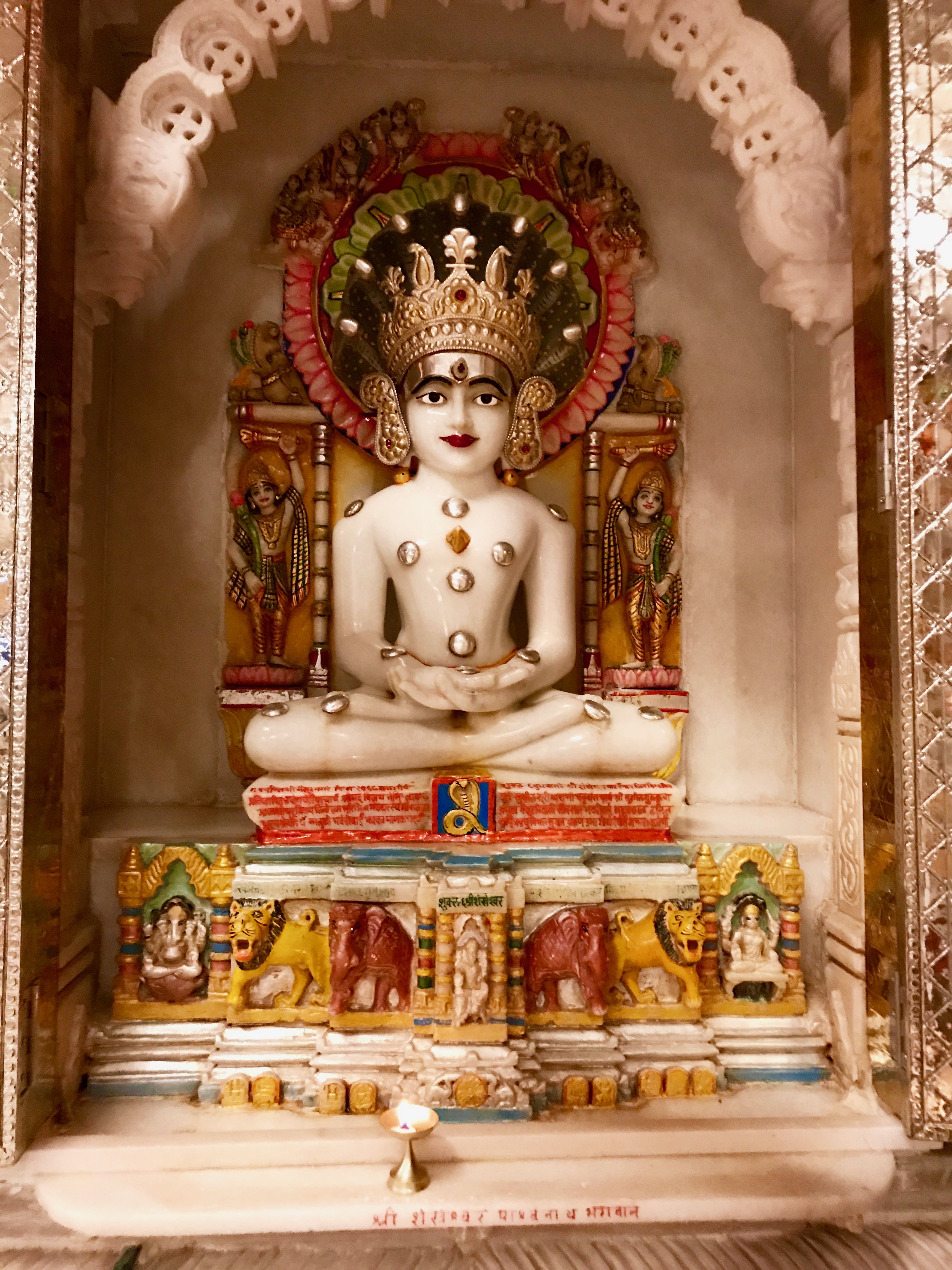|
Gaccha
Gaccha, alternatively spelled as Gachchha, is a monastic order, along with lay followers, of the idol worshipping Murtipujaka Śvetāmbara sect of Jainism. Etymology ''Gaccha'' literally means "who travel together". History According to Jain tradition, in the first century, Vajrasensuri established four ''Kulas'', subdivisions within the Swetambara Murtipujaka Jain community, to divide the community during time of drought to disperse them. They were: Chandra, Nirvriti, Vidyadhar and Nagendra. During 1000 to 1300 CE, the Gaccha replaced these ''Kula'' as basic divisions of community. Although some 84 separate gacchas have appeared since the 7th–8th century, only a few have survived, such as the Kharatara, the Tapa, the Achal, the Paichand or Parshwachandra Gaccha. While the gacchas do not differ from one another in matters of doctrine, they do differ on issues of practice, in particular those practices relating to the sacred calendar and to ritual. The various gacchas al ... [...More Info...] [...Related Items...] OR: [Wikipedia] [Google] [Baidu] [Amazon] |
Murtipujaka
Mūrtipūjaka (lit. "image-worshipper"), also known as Derāvāsī ("temple-dweller") or Mandir Mārgī ("follower of the temple path"), is the largest sect of Śvētāmbara, Śvetāmbara Jainism. Mūrtipūjaka Jains differ from both Śvetāmbara Sthānakavāsī and Śvetāmbara Terāpanthī Jains in that they worship images of the Tirthankara, Tīrthaṅkaras. Mūrtipūjaka may also generally describe members of both the Śvetāmbara and Digambara traditions who use idols (''Murti, mūrti'') in their worship (''pūjā''). Agreements and disagreements According to Nalini Balbir, all Śvetāmbara sects agree upon "the authority of the Śvetāmbara canonical scriptures, with slight differences; claims of monastic descent from Sudharmaswami, Sudharman, except for the Upkeśa Gaccha, Upakeśa Gaccha; [and] white monastic robes [for] monks and nuns." However, despite these commonalities, a central division exists between each of the sects as related to the use of images in worship. ... [...More Info...] [...Related Items...] OR: [Wikipedia] [Google] [Baidu] [Amazon] |
Achal Gaccha
Achal Gaccha, also known as the ''Vidhipakṣa'' or ''Anchal Gaccha'' () is one of the four existing Gacchas and one of the 84 ''gacchas'' of the Śvetāmbara Murtipujaka sect of Jainism. It was founded by Acharya Aryarakshitsuri in 1079 CE in response to the laxity that had crept into monasticism. Except for some minors differences, the rules and rituals of Achal Gaccha are similar to all the other existing ''gacchas'' of the Śvetāmbara Murtipujaka sect. Currently, Acharya Kalāprabhasāgarsuri is the ''gacchadhipati'' of Achal Gaccha who was declared as Gunodayasāgarsuri's successor after his demise in 2020. Acharya Kalāprabhasāgarsuri was formally coronated as the ''gacchadhipati'' of Achal Gaccha in 2022 in Mulund. History and origin Akin to the remaining three, Achal Gaccha traces its roots to the then ''Vada Gachha'' which was the unbroken lineage of monks, starting with one of Mahavira's 11 Ganadharas, Sudharmaswami. Initially, the name of Achal Gaccha was ' ... [...More Info...] [...Related Items...] OR: [Wikipedia] [Google] [Baidu] [Amazon] |
Aryarakshitsuri
Aryarakshitsuri (c. 1080 CE1180 CE) was Śvetāmbara Jain monk and the founder of the Achal Gaccha of the Śvetāmbara sect of Jainism. He was a contemporary of Hemchandrasuri and is said to have met him. Early life He was born as Vayja Kumar to Dedi and Dron in the Pragwat community in a small village Dantani near Mount Abu, Rajasthan, India on 9th day of bright half of Shravan month in 1080 CE. He also had a younger brother named Solha. Initiation At the age of 6, on the 8th day of bright half of Vaishakh month in 1086 CE, Vayja Kumar was initiated as a Jain monk by Acharya Jaysinghsuri at Dantani, his birth place. He was named as Muni Vijayachandra by his preceptor Acharya Jaysinghsuri. After his initiation as a Jain monk, he studied Jain Aagams, Sanskrit and Prakrit grammar, poetries, law theories, prosody, lexicography, and philosophy under the guidance of his preceptor. He also learned different mantras, hymns, and other meditation techniques from Acharya Jays ... [...More Info...] [...Related Items...] OR: [Wikipedia] [Google] [Baidu] [Amazon] |
Upkeśa Gaccha
Upkeśa Gaccha is the oldest ''gaccha'' (monastic order) of Śvetāmbara Jainism. It is one of the 84 ''gacchas'' of the Śvetāmbara sect that were once in existence. Unlike most other ''gacchas'' that follow Mahavira's lineage and begin with his disciple Sudharmaswami, it follows the lineage of the 23rd Tirthankara Parshvanatha and is said to have begun with his prime disciple ''Ganadhara Shubhadatta''. It went extinct in about 1930 CE. History According to Śvetāmbara scriptures, lineage-wise, Upkeśa Gaccha is the oldest of all the 84 ''gacchas'' to ever exist. It is said to be of Parshvanatha's lineage. Historically, Parshvanatha's ''śāsana-kāl'' () was 250 years, which is the smallest difference between two Tirthankaras in this Avasarpiṇī. As a result, ascetics of Parshvanatha's unbroken lineage were around when Mahavira was born. As per Kalpa Sūtra, an important canonical scripture of the Śvetāmbaras, Mahavira's parents were Śrāvakas (lay-followers) o ... [...More Info...] [...Related Items...] OR: [Wikipedia] [Google] [Baidu] [Amazon] |
Śvetāmbara
The Śvetāmbara (; also spelled Shwetambara, Shvetambara, Svetambara or Swetambara) is one of the two main branches of Jainism, the other being the Digambara. ''Śvetāmbara'' in Sanskrit means "white-clad", and refers to its ascetics' practice of wearing white clothes, which sets it apart from the ''Digambara'' or "sky-clad" Jains whose ascetic practitioners go nude. Śvetāmbaras do not believe that ascetics must practice nudity. The Śvetāmbara and Digambara traditions have had historical differences ranging from their dress code, their temples and iconography, attitude towards Jain nuns, their legends and the texts they consider as important. Śvetāmbara Jain communities are currently found mainly in Gujarat, Rajasthan and coastal regions of Maharashtra. According to Jeffery D. Long, a scholar of Hindu and Jain studies, about four-fifths of all Jains in India are Śvetāmbaras. History and lineage Śvetāmbaras consider themselves to be the original followers of Maha ... [...More Info...] [...Related Items...] OR: [Wikipedia] [Google] [Baidu] [Amazon] |
Tapa Gaccha
Tapa Gaccha is the largest Gaccha (monastic order) of Śvetāmbara Jainism. More than half of the existing Jain ascetics belong to the Tapa Gaccha. Several successful Sanskrit scholars belonged to Tapa Gaccha, including Hiravijaya, Meghavijaya, Yashovijaya, Vijayanandsuri among others. Panyas Bhadrankarvijaya was also a notable monk who came in contact with Acharya Ramchandra Suri before initiation as a monk in Tapa Gaccha. History Tapa Gaccha was founded by Acharya Jagatchandra Suri in Vikram Samvat 1285 (1228 AD). He was given the title of "Tapa" (i.e., the meditative one) by the ruler of Mewar. This title was applied to the whole group. Under Vijayanandsuri's leadership and other monks, the Shwetambara Murtipujak Conference was established in 1893 which reformed mendicant as well as lay religious practices. As a result of this reform, most Shwetambara Jain monks today belong to Tapa Gaccha. Today, the majority of its followers live in states such as Gujarat, Maharashtra, T ... [...More Info...] [...Related Items...] OR: [Wikipedia] [Google] [Baidu] [Amazon] |
Kharatara Gaccha
Kharatara Gaccha is one of Śvetāmbara Murtipujaka Gacchas. It is also called the Vidhisangha (the Assembly) or Vidhimarga (Path of Proper Conduct), as they regard their practices as scripturally correct. History Kharatara Gaccha was founded by Vardhamana Sūri (till 1031 CE). His pupil, Jineshvara (the author of Nivvāṇalīlāvaīkahā), got honorary title 'Kharatara' (Sharp witted or Fierce) because he defeated Suracharya, leader of Chaityavasis in public debate in 1024 CE at Anahilvada Patan. So the Gaccha also got his title. Khartara also means that "which is beyond" (tara) "purity" (khara), that is, being upright with the absolute truth, by following the religious scriptures without deviation (Jain Agamas) as it is. Another tradition regards Jinadatta Suri (1075―1154) as a founder of Gaccha. Jinavallabha realised the difference between texts and words of teachers and put emphasis on sacred texts in Kharatara doctrine in the eleventh century. He wrote the ''Crown o ... [...More Info...] [...Related Items...] OR: [Wikipedia] [Google] [Baidu] [Amazon] |
Kali
Kali (; , ), also called Kalika, is a major goddess in Hinduism, primarily associated with time, death and destruction. Kali is also connected with transcendental knowledge and is the first of the ten Mahavidyas, a group of goddesses who provide liberating knowledge. Of the numerous Hindu goddesses, Kali is held as the most famous. She is the preeminent deity in the Hindu tantric and the Kalikula worship traditions, and is a central figure in the goddess-centric sects of Hinduism as well as in Shaivism. Kali is chiefly worshipped as the Divine Mother, Mother of the Universe, and Divine feminine energy. The origins of Kali can be traced to the pre-Vedic and Vedic era goddess worship traditions in the Indian subcontinent. Etymologically, the term ''Kali'' refers to one who governs time or is black. The first major appearance of Kali in the Sanskrit literature was in the sixth-century CE text '' Devi Mahatmya''. Kali appears in many stories, with the most popular one bein ... [...More Info...] [...Related Items...] OR: [Wikipedia] [Google] [Baidu] [Amazon] |
Ambika (Jainism)
In Jainism, Ambika (, "Mother") or Ambika Devi ( "the Goddess-Mother") is the "dedicated attendant deity" or "protector goddess" of the 22nd Tirthankara, Neminatha. She is also known as ''Ambai'', ''Amba'', ''Kushmandini'' and ''Amra Kushmandini''. She is often shown with one or more children and often under a tree. She is frequently represented as a pair (Yaksha Sarvanubhuti on the right and Kushmandini on the left) with a small Tirthankar image on the top. The name ''ambika'' literally means mother, hence she is Mother Goddess. The name is also a common epithet of Hindu Goddess Parvati. Etymology The name Ambika is a Sanskrit word, that translates to mother. Legend According to Jain texts, Ambika is said to have been an ordinary woman named Agnila who became a Goddess. She lived in the city of Girinagar with her husband, ''Soma'' and her two children, ''Siddha'' and ''Buddha'' as per the Śvetāmbara tradition, or with her husband ''Somasarman'' and her t ... [...More Info...] [...Related Items...] OR: [Wikipedia] [Google] [Baidu] [Amazon] |
Mulund
Mulund (Pronunciation: uluɳɖ is a suburb in the north-east of Mumbai, Maharashtra, India. It comes under the zone railway station on the Central Railway line of the Mumbai Suburban Railway. It was first the railway station of the Mumbai Suburban district on the central railway line.The nextt station i, Thane railway station, which comes under the Thane district. It is nestled alongside the foothills of the Sanjay Gandhi National Park with easy access to the Eastern Express Highway and Navi Mumbai through the Mulund-Airoli Bridge. Mulund marks the end of Mumbai city. History Mulund's history is said to date back to the time of the Mauryan Empire. Referred to at that time as Muchalind, its name changed to Mul-Kund which then modified to its present name. At one point in time, the name Manglapuri was also associated with it. It is said to be the earliest planned neighborhood of Mumbai city. In 1922, a zamindar, Jhaverbhai, who owned Jhaverbhai Narottamdas & Company, gave ar ... [...More Info...] [...Related Items...] OR: [Wikipedia] [Google] [Baidu] [Amazon] |
Mahavira
Mahavira (Devanagari: महावीर, ), also known as Vardhamana (Devanagari: वर्धमान, ), was the 24th ''Tirthankara'' (Supreme Preacher and Ford Maker) of Jainism. Although the dates and most historical details of his life are uncertain and varies by sect, historians generally consider that he lived during the 6th or 5th century BCE, reviving and reforming a proto-Jain community (which had possibly been founded by Pārśvanātha), and that he was an older contemporary of Gautama Buddha. Jains regard him as the spiritual successor of the 23rd ''Tirthankara'' Parshvanatha. According to traditional legends and hagiographies, Mahavira was born in the early 6th century BCE to a royal Kshatriya Jain family of ancient India. His mother's name was Trishala and his father's name was Siddhartha. According to the second chapter of the Śvētāmbara Ācārāṅga Sūtra, Siddhartha and his family were devotees of Parshvanatha. Mahavira abandoned all worldly p ... [...More Info...] [...Related Items...] OR: [Wikipedia] [Google] [Baidu] [Amazon] |






